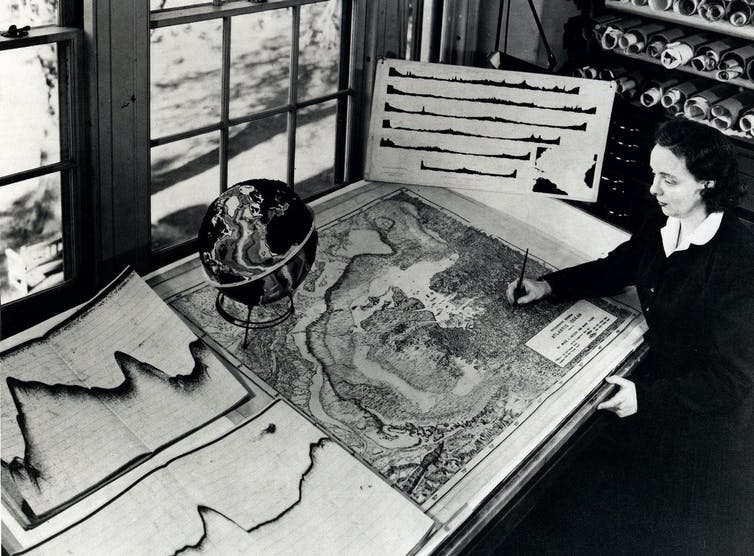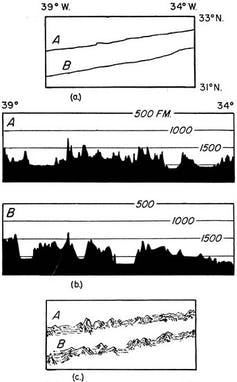Behind some of the most fascinating scientific discoveries and innovations are women whose names might not be familiar but whose stories are worth knowing.
Of course, there are far too many to all fit on one list.
But here are five profiles from The Conversation’s archive that highlight the brilliance, grit and unique perspectives of five women who worked in geosciences, math, ornithology, pharmacology and physics during the 20th century.

Marie Tharp with an undersea map at her desk. Rolled sonar profiles of the ocean floor are on the shelf behind her.
Lamont-Doherty Earth Observatory and the estate of Marie Tharp
1. Revealing and mapping the ocean floor
As late as the 1950s, wrote Wesleyan University geoscientist Suzanne OConnell, “many scientists assumed the seabed was featureless.”

An illustration of Marie Tharp’s mapping process. (a) Shows the position of two ship tracks (A, B) moving across the surface. (b) Plots depth recordings as profiles. (c) Sketches features shown on the profiles.
The Floors of the Ocean, 1959, Fig. 1
Enter Marie Tharp. In 1957, she and her research partner started publishing detailed hand-drawn maps of the ocean floor, complete with rugged mountains, valleys and deep trenches.
Tharp was a geologist and oceanographer. Aboard research ships, she would carefully record the depth of the ocean, point by point, using sonar. One of her innovations was to translate this data into topographical sketches of what the seafloor looked like.
Her discovery of a rift valley in the North Atlantic shook the world of geology – her supervisor on the ship dismissed her idea as “girl talk,” and Jacques Cousteau was determined to prove her wrong. But she was right, and her insight was a key contribution to plate tectonic theory. That’s part of why, OConnell writes, “I believe Tharp should be as famous as Jane Goodall or Neil Armstrong.”
À lire aussi :
Marie Tharp pioneered mapping the bottom of the ocean 6 decades ago – scientists are still learning about Earth’s last frontier
2. Sympathetic observation of bird behavior
Margaret Morse Nice was a field biologist who got into the minds of her study subjects to garner new insights into animal behavior. Most famously she observed song sparrows in the 1920s and ‘30s.
Rochester Institute of Technology professor of science, technology and society Kristoffer Whitney recounted what Nice called her “phenomenological method,” acknowledging the obvious “affection and anthropomorphism” you can see in her descriptions.
“When I first studied the Song Sparrows,” Nice wrote, “I had looked upon Song Sparrow 4M as a truculent, meddlesome neighbor; but … I discovered him to be a delightful bird, spirited, an accomplished songster and a devoted father.”
Despite earning no advanced degrees and being considered an amateur, Nice promoted…
